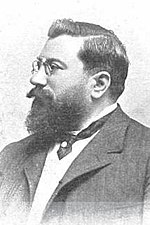Manuel Lezama Leguizamón Sagarminaga
[2] Some of its representatives rose to high posts in Madrid;[3] The Biscay branch, apart from having been among the largest landholders in the region, specialized as merchants and were army suppliers.
He kept obtaining new mining concessions,[a] counted among “destacados miembros de las élites bilbaína” and owned one of the most successful industrial conglomerates in Biscay.
[f] The best-known of Manuel's relatives was his younger brother Luis Lezama Leguizamón Sagarminaga, who was also an entrepreneur who in the early 1930s served as the provincial Carlist leader in Biscay.
[43] The last note of the mine having been exploited by Lezama comes from 1924,[44]"Encarnación" was operated since 1915,[45] "Ribadesella" also from 1915,[46] "Felisa" from 1916,[47] the jewel in the crown was "Abandonada",[48] an iron ore opencast pit in Miribilla.
[49] Some mines were equipped with transportation systems or washeries that provided services to competitive companies;[50] part of their infrastructure was so advanced it gained scientific articles.
[51] It is estimated the Lezama conglomerate accounted for 5–6% of the Biscay iron ore production, and even during the World War I crisis it produced 110–122 thousand tons.
For decades engaged in lawsuits against municipal authorities,[55] The Lezamas had many differences with the city councils of Bilbao and Getxo,[56] and were subject to legal investigation as far as in Britain.
He was among stakeholders of La Robla, a new railway line that linked Bilbao with León and Palencia;[58] Since the mid-1890s, during at least 20 years he was sitting in the executive board of the company.
[69] The Lezama Leguizamóns are not counted among the very top elite of Biscay industrial tycoons[70] formed by the Ybarra, Martínez Rivas, Chávarri, Sota and Echevarrieta families;[71] however, they are listed as members of the emergent Basque oligarchy;[72] their name repeatedly appears in the history of Biscay industrialization[73] and their companies are listed among the most important in Bilbao in the first decades of the 20th century.
[l] There is no information on Lezama's political engagements during his youth; the first one known was the 1892 honeymoon trip, when the couple travelled to Venice to pay homage to Carlos VII.
[87] His term as consejero and teniente de alcalde lasted 4 years[88] and in 1897 he was already absent in municipal government,[89] though it is not clear whether Lezama failed in elections or decided not to stand.
The Carlists formed an alliance named Coalición Católica, joined also by the Basque nationalists and the Integrists;[101] the list emerged triumphant and Lezama was elected.
He remained active in the Carlist ranks, e.g. in 1909 the brothers attended the funeral of Carlos VII;[104] at least since this year Lezama was a member of Junta Señoral, the provincial party executive,[105] and took part in local rallies,[106] but it is not clear whether and how political preferences filtered to his official tasks.
The term expired in 1911 and Lezama was reported to stand in forthcoming elections to get his ticket renewed;[107] it is not clear whether he failed or withdrew, but he was absent in the re-elected self-government.
[110] His understanding of the leadership role was rather traditional; Lezama presided over local feasts like Velada Jaimista in Durango,[111] attended banquets to honor party leaders, e.g. in 1914 to hail the Vascongadas jefe Tirso de Olazabal,[112] and entertained Carlist royals when visiting Biscay, e.g. in 1917 hosting princesses Fabiola and Nieves in Bilbao.
Throughout the 1910s a few times he hosted the theorist in Bilbao; in some cases these visits produced security concerns on the part of the administration, and Civil Guard was deployed to prevent any unrest.
In 1924, the Lezama brothers co-signed a manifesto that pledged support to the dictator, though they declared no Traditionalist could accept the 1876 constitution as basis for further action, they nevertheless recommended entering Unión Patriótica.







